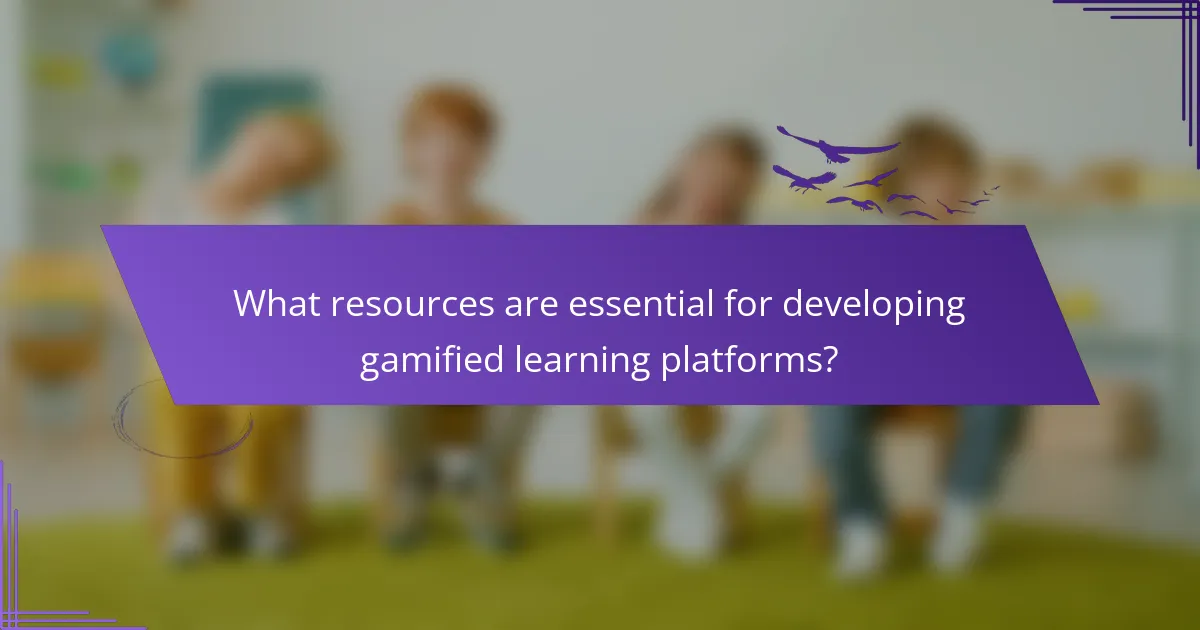The development of gamified learning platforms is shaped by various economic influences, such as market demand and investment trends, which affect budgeting and resource allocation. A strategic approach to budgeting is essential, as it involves evaluating development costs and securing funding to ensure the platform is both engaging and educational. Effective resource management, including technology and skilled personnel, is crucial for creating a successful learning experience.

What are the key economic influences on gamified learning platform development?
The development of gamified learning platforms is significantly influenced by various economic factors, including market demand, investment trends, and the impact of economic downturns on budgets. Understanding these influences helps in making informed decisions about resource allocation and budgeting for such projects.
Market demand for online education
The rising demand for online education is a crucial economic influence on gamified learning platforms. As more learners seek flexible and engaging learning experiences, platforms that incorporate gamification are increasingly favored. This trend is particularly strong among younger demographics who are more accustomed to digital interactions.
To capitalize on this demand, developers should focus on creating interactive and engaging content that appeals to users’ preferences. Regularly gathering feedback from target audiences can help refine offerings and ensure they meet market needs effectively.
Investment trends in EdTech
Investment in EdTech has seen substantial growth, with venture capital flowing into innovative learning solutions. Gamified platforms are often viewed as attractive investments due to their potential to enhance learner engagement and improve educational outcomes. Investors are particularly interested in platforms that demonstrate scalability and measurable results.
To attract investment, developers should clearly articulate their value proposition and showcase successful case studies. Networking within the EdTech community and attending relevant conferences can also help in securing funding opportunities.
Impact of economic downturns on budgets
Economic downturns can lead to tighter budgets for educational institutions and organizations, affecting their ability to invest in new technologies, including gamified learning platforms. During such periods, decision-makers may prioritize essential expenditures, making it crucial for developers to demonstrate cost-effectiveness and ROI.
To navigate budget constraints, developers should consider offering tiered pricing models or subscription-based services that allow institutions to access gamified content without significant upfront costs. Highlighting long-term savings through improved learner outcomes can also help persuade stakeholders during economic challenges.

How to budget for gamified learning platforms?
Budgeting for gamified learning platforms involves assessing development costs, identifying funding sources, and allocating resources effectively. A well-structured budget ensures that all necessary features are developed while also promoting the platform effectively.
Cost estimation for development
Estimating the cost of developing a gamified learning platform requires analyzing various factors, including design, technology, and content creation. Development costs can range from low tens of thousands to several hundred thousand dollars, depending on complexity and scale.
Consider breaking down costs into categories such as software development, graphic design, and user experience testing. This approach allows for a clearer understanding of where funds are allocated and helps identify potential areas for cost savings.
Funding sources for EdTech projects
Funding for EdTech projects can come from multiple sources, including government grants, private investors, and crowdfunding platforms. Many educational institutions and organizations offer grants specifically for innovative learning solutions, which can significantly reduce financial burdens.
Additionally, venture capital firms are increasingly interested in the EdTech sector, providing opportunities for startups to secure investment. Exploring partnerships with educational institutions can also yield funding and resources.
Budget allocation for features and marketing
When allocating a budget for features and marketing, prioritize essential functionalities that enhance user engagement and learning outcomes. A common approach is to allocate around 60-70% of the budget to development and features, while reserving 30-40% for marketing efforts.
Marketing strategies should include digital advertising, social media campaigns, and partnerships with educational organizations. Regularly reviewing and adjusting the budget based on user feedback and market trends will help ensure the platform remains competitive and effective.

What resources are essential for developing gamified learning platforms?
Developing gamified learning platforms requires a blend of technology, skilled personnel, and partnerships with content providers. These resources ensure the platform is engaging, educational, and technically sound.
Technology stack requirements
A robust technology stack is crucial for building effective gamified learning platforms. Key components typically include a front-end framework (like React or Angular), a back-end server (such as Node.js or Django), and a database (like MongoDB or PostgreSQL). Additionally, integrating game engines like Unity or Unreal Engine can enhance interactivity.
When selecting technologies, consider scalability and user experience. Aim for a stack that supports responsive design for various devices, as learners may access content on desktops, tablets, or smartphones. Regular updates and security patches are essential to maintain platform integrity.
Human resources and skill sets needed
Creating a successful gamified learning platform requires a diverse team with specific skill sets. Key roles include software developers, UX/UI designers, instructional designers, and project managers. Each member should understand both educational principles and game mechanics to create an engaging learning experience.
Consider hiring specialists in game design and educational psychology to ensure the platform meets learners’ needs. Additionally, ongoing training for staff can help keep the team updated on the latest trends in both technology and education.
Partnerships with content providers
Forming partnerships with content providers is essential for sourcing high-quality educational materials. Collaborating with educational institutions or subject matter experts can enhance the platform’s credibility and content richness. This can include licensing existing courses or co-developing new materials.
When establishing partnerships, ensure that the content aligns with your platform’s goals and audience needs. Clear agreements on revenue sharing, content updates, and intellectual property rights are vital to avoid potential conflicts and ensure a smooth collaboration.

What are the best practices for resource allocation?
Effective resource allocation in gamified learning platform development involves strategically distributing assets to maximize impact and efficiency. Key practices include prioritizing features based on user feedback and employing agile methodologies for project management.
Prioritizing features based on user feedback
Gathering and analyzing user feedback is crucial for prioritizing features that enhance engagement and learning outcomes. Conduct surveys, interviews, and usability tests to identify which elements resonate most with users.
Once feedback is collected, categorize features into must-haves, nice-to-haves, and future considerations. This helps in focusing development efforts on the most impactful features first, ensuring that resources are allocated effectively.
Regularly revisiting user feedback throughout the development cycle allows for adjustments and improvements, keeping the platform aligned with user needs and expectations.
Agile methodologies for project management
Agile methodologies promote flexibility and iterative progress, making them ideal for resource allocation in gamified learning platform development. By breaking projects into smaller, manageable tasks, teams can quickly adapt to changes and reallocate resources as needed.
Utilize frameworks like Scrum or Kanban to facilitate regular check-ins and updates. This encourages collaboration and ensures that all team members are aligned on priorities, which can lead to more efficient use of resources.
Establish clear metrics for success and regularly assess progress against these benchmarks. This allows for informed decisions on where to allocate resources for maximum impact, minimizing waste and enhancing overall project outcomes.

What are the potential challenges in gamified learning platform development?
Gamified learning platform development faces several challenges that can hinder its effectiveness and success. Key issues include technical difficulties in implementation and maintaining user engagement and retention.
Technical challenges in implementation
Implementing a gamified learning platform often involves complex technical requirements, including software integration, user interface design, and data management. Developers must ensure that the platform is compatible with various devices and operating systems, which can increase development time and costs.
Additionally, maintaining system performance under high user loads is crucial. Platforms should be designed to handle peak usage without lag, which may require robust server infrastructure and regular performance testing.
User engagement and retention issues
Engaging users effectively is a common challenge in gamified learning. If the game mechanics are not well-aligned with educational goals, users may lose interest quickly. It’s essential to balance educational content with enjoyable gameplay to keep learners motivated.
Retention strategies should include regular updates, rewards for progress, and community features to foster interaction. Monitoring user feedback and analytics can help identify areas for improvement and enhance the overall experience, ensuring users remain engaged over time.

How do trends in gamification affect learning outcomes?
Trends in gamification significantly enhance learning outcomes by increasing engagement and retention. By integrating game elements into educational platforms, learners often experience improved motivation and a more interactive learning environment.
Increased motivation through game mechanics
Game mechanics, such as points, badges, and leaderboards, can greatly boost learner motivation. These elements create a sense of achievement and competition, encouraging users to participate actively and persist through challenges. For instance, earning badges for completing modules can incentivize learners to engage more deeply with the material.
To maximize motivation, consider incorporating a variety of rewards that appeal to different learner preferences. Some may be driven by competition, while others might prefer personal achievements. Balancing these elements can help maintain interest and engagement over time.
Data analytics for performance tracking
Data analytics play a crucial role in tracking learner performance within gamified platforms. By collecting and analyzing data on user interactions, educators can identify trends, strengths, and areas needing improvement. This insight allows for tailored learning experiences that address individual needs.
Implementing analytics tools can help educators monitor progress in real-time, enabling timely interventions when learners struggle. Regularly reviewing performance metrics can inform adjustments to content and game mechanics, ensuring that the learning experience remains effective and engaging.

What are the emerging trends in gamified learning platforms?
Emerging trends in gamified learning platforms focus on enhancing user engagement and improving educational outcomes through innovative technologies. Key developments include the integration of artificial intelligence and machine learning, personalized learning experiences, and the use of immersive technologies like virtual and augmented reality.
Integration of AI and machine learning
The integration of AI and machine learning in gamified learning platforms allows for personalized learning experiences tailored to individual user needs. These technologies analyze user behavior and performance data to adapt content and challenges in real-time, ensuring that learners remain engaged and motivated.
For instance, AI can assess a learner’s strengths and weaknesses, adjusting the difficulty of tasks accordingly. This dynamic approach helps maintain an optimal challenge level, which is crucial for effective learning. Additionally, machine learning algorithms can predict future learning paths, guiding users toward resources that will benefit them most.
When implementing AI and machine learning, consider the balance between automation and human oversight. While these technologies can enhance personalization, they should complement, not replace, the role of educators. Regularly review AI-driven recommendations to ensure they align with educational goals and standards.


